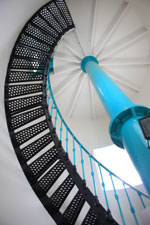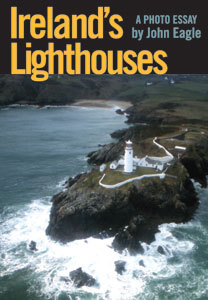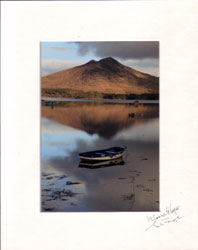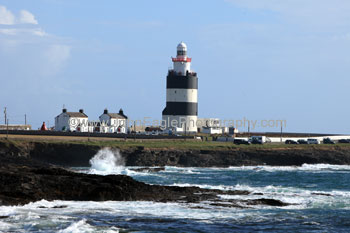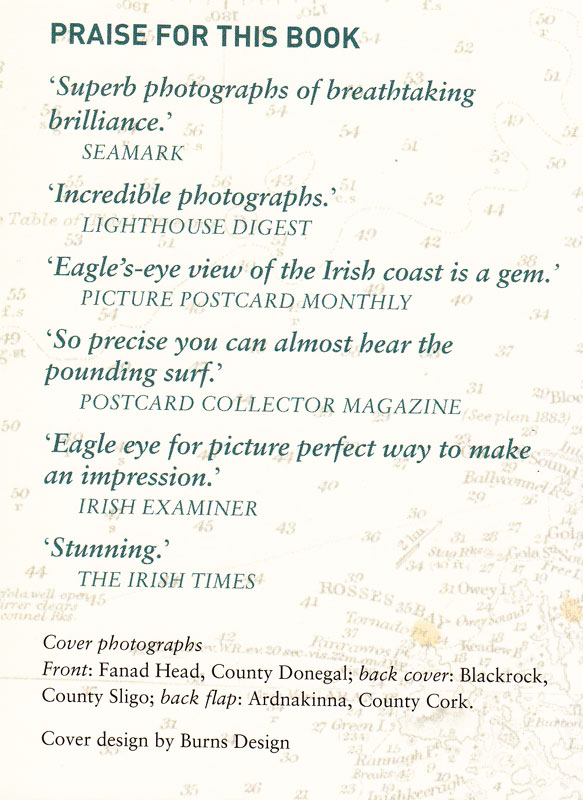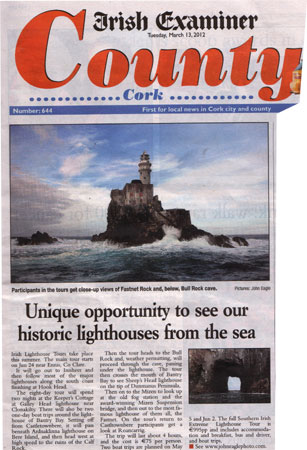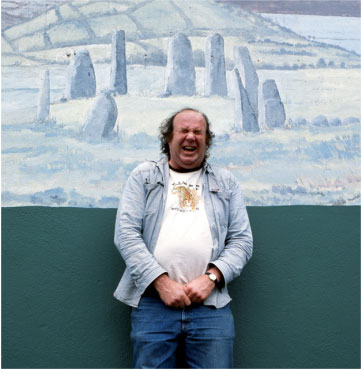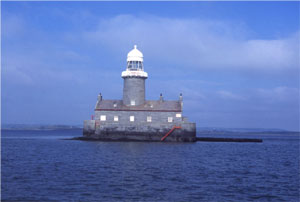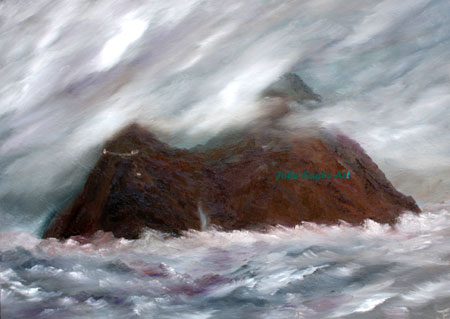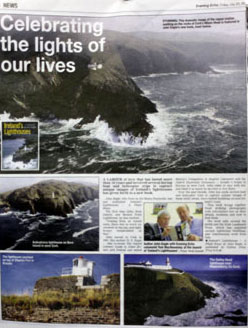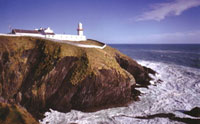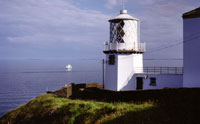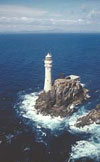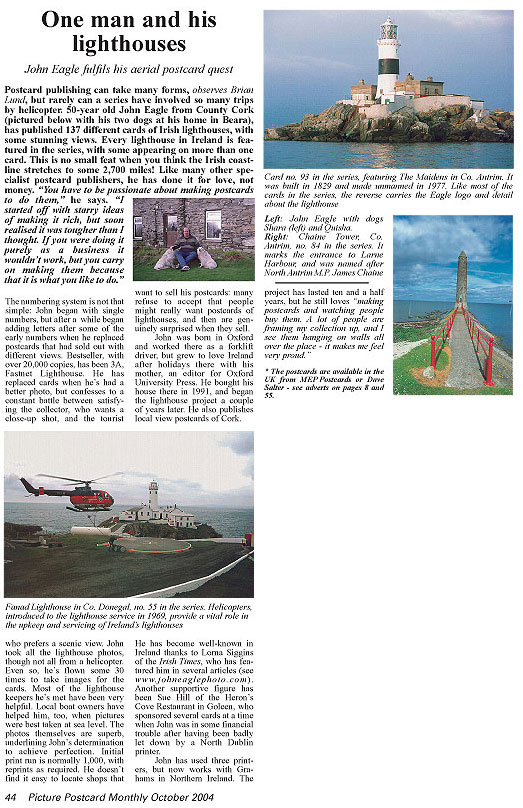John Eagle Photography
| Photographs | My Shop | Books | Art Gallery | Contact |
|
What the papers say Praise for artist/photographer John Eagle 2 Lighthouse books and a collection of postcards
Featured on the front page of The County March 13th 2012 regarding my tours of Irish lighthouses Loop roots ~ Peter McDermott Echo Arts & Lifestyle. Irish Echo One of my great grandmothers was born and raised in West Clare, which she left for Dublin as a young woman. Family information retained who lived in her villageinto the late 20th century said that her maternal grandmother before her was known as the 'woman from the West' That ancestor didn't come from Arizona, however or some other unlikely far flung place. Rather, she was from Loop Head which is that southwestern tip of Clare, easily identifiable on maps and satellite pictures at the mouth of the Shannon Estuary. They said that she walked barefoot the 15 or so miles eastward shortly before her marriage. The two obvious features I recall from my own visit to Loop Head were the mounds of rubble that had once been family homes and its lighthouse, which was established on May 1st 1854. All that makes me favourably disposed towards 'Ireland's Lighthouses A Photo Essay by John Eagle'. The author photographer tells us that Loop Head tower was built on the site of the original 17th-century cottage type light. It was electrified in 1971 and automated 1991. Eagle writes. 'Please be advised if taking small children that, while the land surrounding the lighthouse looks great for playing on, the cliffs are unprotected and very dangerous. 'I spent the night there,' he adds, 'to take pictures for the Irish Landmark Trust, a wild location but simply heavenly in the snug keeper's cottage.' Indeed the keeper's cottage is available to let as a self catering vacation home, he tells us. 'It is remote, a place to get away and have a great escape from the busy life,' Eagle says. The Loop Head lighthouse itself may not be the prettiest of the 80 or so featured in this splendid volume, but the peninsula was selected as an EDEN in 2010, ie European Destination of Excellence. 'Ireland's Lighthouses A Photo Essay by John Eagle is published in paperback by Collins Press/Dufour Editions (7 x 10 format; 216 pp) The Extremes of Eire Kim Fahlen Published in the Lamp Winter 2011/2012 The quarterly journal of the Association of Lighthouse Keepers It was extreme! Our Irish lighthouses caper was extremely exciting, extremely fun, extremely well organized, and with an extremely cordial company of fellow lighthousers. Artist, photographer, and author John Eagle organized, then led a fantastic tour of his adopted and beloved southern Eire. Nine travelers representing England, Germany, and the U.S. gathered in Bunratty on 15 August. (The only two non-members of Association of Lighthouse Keepers were soon, let’s say, formally introduced to it. That’s our Keith Morton!) John graced us with a slide show of his photographs and paintings. Though he specializes in lighthouses, John leaves no doubt as to the intensity of his affection for the landscapes and moods of the counties Kerry and Cork. And of his sheepdog Suzie. After a day or two of witnessing the colors of Ireland, I rendered a confession to John for what I came to realize had been uncharitable thoughts. Though I certainly had not voiced it outside my mind, during his above-noted photo showing, I wondered at the rather unnatural, exaggerated blue coloration of so many pictures. Ireland may own “forty shades of green”, but near Irish waters, green will be outnumbered by hues in blue! Our compellingly charming, accommodating, and skillful driver, Tommy Harnett, gave perfect balance to John’s caring, easy-going, and mellow demeanor. Maybe it was just we Americans, but oh, how we laughed that we could understand John or Tommy (sometimes!) when they spoke individually, but when to each other, barely a word could we comprehend! Travel in the mini-bus was congenial as scenes changed outside its windows. “If it’s Tuesday, it must be County Clare.” So it was as John uttered, and our first lighthouse to call on was the 1854 Loop Head, a classic Irish beauty with its spirited orange, out-reaching, curved lantern railing and white bracing stanchions. Loop Head was newly opened for public visitation, so this allowed an interior ogle. In spite of the affronting (okay, necessary) wire netting that prevented proper appreciation of the lens rotation equipment, we had access to the outside gallery. From there, looking up into the lantern glazing, we saw azure sky and sea and puffy clouds reflecting in the ever-turning ‘faces’ of the fine old optic. East along the Clare coast is the enchanting squat stone tower of Kilcredaun. Another George Halpin-engineered lighthouse, it began service in 1824. (George Halpin, Sr. was Engineer to the Port of Dublin Corporation in the early-mid 1800s.) The interior was eye-catching—paintwork was meticulous everywhere. And there is a fairy door that leads from lantern to gallery. Attendant Steven Rowan was kind and generous with his time as he spoke about the light station. But melancholy was sneaking into round corners. The light is dark now, permanently discontinued in March. The lighthouse at the Shannon estuary stands every bit as self-respecting as when it was built 177 years ago, undaunted by two 400-500-foot Tarbert Power Station chimneys nearby. We passed Tarbert light crossing by ferry, on which two of the most remarkably sorriest-looking black birds were mooching a ride. It is a contented lighthouse on Little Samphire Island—maybe because of the company it keeps with the beautiful Slieve Mish Mountains along the Dingle Peninsula. We trekked along the water’s edge to get nearer the 1854 light station, and leave it Gerry! He would know that “samphire” is a plant that grows on rocks by the sea. He found some growing there and had us all tasting it, saying that it is used in salads in fancy restaurants. Speaking of restaurants, we dined as a group for most meals along our travels, which made for a lot of fun. Each one of the three “extreme” lighthouses we experienced could own a pages-long narrative, and certainly, a photographic one. Ineffable panoramas just getting out to Michael Skelling, Bull Rock, and the Fastnet fill a person with wonder! The lighthouse structures themselves tend to lack the appeal of the old ones; their 1960s lantern design is all business. It is the shock of orientation on and within the rock, the placement of tower and dwellings and multifarious stairs leading to them from the sea, the trusted derrick platforms, and the helicopter pads that are extreme! From Portmagee on the 17th we sailed to the great sea-crag of Skelling Michael. Before disembarking at Blind Man’s Cove, our boat skipper circled the island so we could view the lighthouse. It peeked at us behind rock until we came to face it full on, high on its 53-meter (174 feet) perch; the 1960s-era structures were built on the site of the former 1826 North Station. As we rounded the island, we also caught the extant 1826 North Station tower, standing at altitude nearly twice that of its mate. Skellig Michael is awe-inspiring! This multi-pinnacled nugget of red sandstone and purple and green slate plunges 90 fathoms (540 feet) to sea bottom and reaches a height of 230 meters (755 feet). The variety and abundance of bird-life and sea-life are renowned, so too, the relics of a 6th century monastic Irish Christian settlement 182 meters (597 feet) above the sea. Congratulations to our brave-hearted (foolhardy), steel-witted (out of their mind) climbers who got to the top, or at least, to the clochans (monks’ huts): Kirsten Hempelmann and Claus-Peter Troch, Nancy Olson, John Eagle, and Gerry Douglas-Sherwood. Impressive! The vertiginous, open, uneven stairs cut into the stone with all that sea and sky surrounding, and with dizzying height and depth, is no joke. If only the monks had installed handrails, Laura Chewning, Bette Keeping, Keith Morton and I would have gone for it, though Judy Weeks would not have left her perch just up from the boat dock. In late afternoon we stopped at the Valentia Slate Quarry that operated on and off for nearly 100 years, beginning in 1816; Valentia Slate was famous worldwide and even roofed the Paris Opera House. (Ooooo, Phantom of the Opera.) There were piles of handsome gray slate and great slabs that we wanted to carry home. Tommy stopped his bus for us to snap some pictures of Point Cromwell and the light station on Valentia Island. Then we had an unplanned visit inside the Skellig Experience Visitor Centre, where there is a treasure of Skellig Michael lighthouse history that includes keeper family photograph albums, graphics depicting lighthouse construction, Irish Lighthouse Service china, and much more. Our group absolutely fell in love with the Ring of Beara—the spectacle of mountain, sea, and colorful villages was beguiling. The “back to school flowers” were everywhere; that’s what John called the bright orange Montbretia that blooms in late August. John had arranged an evening meeting with former CIL PK Richard O’Driskoll at his home overlooking Coulagh Bay in Eyeries. PK O’Driskoll spoke of many things. His career with CIL had spanned 48 years and eight months and he was “the last man on the rock”, meaning he was the last keeper at the Fastnet. He said the greatest problem there was the landing and that at the Fastnet, it was “all horse-work with all the rigging and 105 steps.” How many of us have ever given thought to the fact that keepers had to undergo “inversion training” for helicopter travel? As for the lighthouse at Michael Skellig, PK O’Driscoll confessed that there were “times when there would come static on the back of your neck.” “It’s unusual on the Skellig,” and he observed that the island had a “liquid peace” where you “could rub fulmars on the head.” Tuskar Lighthouse was the station he liked the least: “Dirty weather. Dirty landing.” About the Bull Rock Lighthouse, PK O’Driskoll declared, “I used to give three years working on it. Souls on their way to hell pass through here.” So, the next morning, ten other souls swaddled into life preservers and straddled seats aboard a high-speed rib to get out to that Bull Rock. We passed the bright white Ardnakinna Lighthouse on Bere Island that marks the western entrance into Castletownbere in Bantry Bay. Built as a beacon in 1850, this tower was not converted to a lighthouse until 1965. We were allied in extreme excitement as the great Bull Rock got bigger and bigger as the rib closed in on it! Just how does a helicopter pilot have the nerve to land at these offshore stations? What a thrill that our boatman was willing to take us through the rock’s tunnel! Ha! As we cruised through, the boatman beamed, “I’ve never done this before!” It was the stone dwellings of the light station that were most impressive—their almost prison-like construction, now in ruin and consigned to oblivion, made them spooky as if all the windows were gaping mouths crying out. It was perfectly extreme to come upon the frightfully low-to-the-water Calf Rock, a “relative” in legend, of the Bull. The remaining rusted base of the 1864 cast-iron lighthouse tower looks huge up close! The rest of the tower was swept away by hurricane-lashed seas in 1881. I wish I had an idea of the time it took for men to cut stone away to make stairs on all these rock stations. Surprisingly, outbuildings and dwellings on the Calf are of red brick and hump-backed (though stone may be underneath); the whole scene has a curious, intense appeal. Sky was wonderful as we passed Copper Point and then Roancarrig Lighthouse in Bantry Bay, which made the tower’s black band striking with the white. The station on its long, narrow island was Halpin-designed and first lighted in 1847. Across from it, Hungry Hill along the Beara Peninsula was bathed in moody blues. Galley Head! It’s a beautiful station with its biform lens and turquoise blue on handrails, weight-tube, lens pedestal, etc. And no wire netting was there to scold us to keep away! The tower is immaculate and there is no way you will find a cuter lighthouse attendant! Gerald Butler belongs to a family recognized for its long and exceptional service with CIL; even his mother preceded him in tending the station. He couldn’t have been more friendly and willing to talk with us. We read about it, see many pictures of it, daydream about it, and think we know it well, but the thrill of coming face-to-face with the Fastnet lighthouse is the ultimate extreme! Sailing around it, witnessing the massive fabric of the rock, and of the transition of tower into it, had us spellbound! The barricaded windows and doors of the 1897 barracks looked like a patchwork quilt, especially because the hinges look like stitches, but it’s a sorry and abandoned ‘quilt’. Actually observing the limitations keepers lived with, and the danger even in good weather, was jolting. Here we were really watching the Fastnet’s mighty optic rotate, the one in all the books with the little man standing beside it. The entire sight surely gave us “food and thought for future years” (Wordsworth), though even now, it’s hard to believe we were really out there. So often we were lucky with the light and sky that gained us advantage for the bazillions of photographs we snapped. This was too true as we looked across Roaringwater Bay to Crookhaven Lighthouse. Earlier in the afternoon (the 20th) we had visited the Mizen in soft sunshine. We crossed the new footbridge—the gorge below is spectacular! The structures that formerly belonged to the fog signal station of 1909 and, ultimately, the 1959 lighthouse now offer displays related to life at the point. A film about earlier times at the Fastnet runs in one room, in others, are CIL-related documents and antique radio equipment. Something extreme, by way of disappointment, is within the visitor areas at Mizen Head—it is the particular way in which lighthouse lens panels are displayed. Undoubtedly with good intent, but simply hung against walls that allow no light and air behind them is injury to the senses. But there is much clever, meaningful Fastnet-related activity at Mizen Head, all of which is a ‘must-see’. Our last night together was back in Bunratty, near the castle. John Eagle, our new BFF, had organized a fantastic, memorable tour and departing was the least fun of it all. There is so much more that might be noted, so many funny incidents, new friendships, places we stayed, villages we passed, and times that we will happily recall, but I’m out of adjectives. Believe that our caper to the Eire lighthouses was… extreme.
A personally photographed collection of postcards Ireland's Lighthouses A Photo Essay by John Eagle Review by Kathleen Finnegan The Lighthouse Digest The first time he saw Roche’s Point Lighthouse marking Cork Harbor, John Eagle knew he was smitten: ‘Coming from an inland town, there was so much excitement in the sea,’ he explains, ‘and lighthouses encapsulated all that.’ John Eagle's passion for lighthouses and their history is evident in the pages of his latest book. Through his spectacular photography and brief histories, it is plain to see where that passion comes from. Eagle's new soft cover book is 210 pages and features 81 lighthouses. The book is broken down by county with a listing of each lighthouse with one or more incredible photographs of each along with brief history, characteristic details and even directions on how to get there. A fun book to browse through and read; and the perfect companion book to take with you on your next trip to Ireland, even if that trip is only though the pages of John Eagle's latest book. The book is available from Lighthouse Books 'Perseverance pays off' David Bedlow, Commissioners of Irish Lights
Ireland's Lighthouses - A Photo Essay by John Eagle Written by Christine
He’s been a rapper, a writer, a forklift driver – photographer, artist and ‘extreme lighthouser’ John Eagle talks to Christine O’Sullivan about flying, painting and the secret of his creativity...
On his eighth birthday, John Eagle was given a simple Kodak film camera as a present from his brother. He smiles at the recollection of using up the entire film taking pictures of the Cutty Sark clipper ship in London. A sensitive child, often distracted in class but inclined towards art and nature, he maintained a casual interest in photography throughout his teens. It was not until he was 23 and steadily employed, however, that he was able to advance his interest. With the prospect of a regular income he blew his first week’s wages on a beginner’s Canon camera. “I remember the thrill of going out to buy it. I wore it out, just blasting off photos.” Since moving from Oxford, England to the Beara Peninsula in Co Cork 19 years ago, Eagle has been deeply inspired by the shores and mountains of his adopted home. He is a seeker of the remote, finding solace in places where the power of nature is tangible. It is something of this thrill in the elements that underlies his love of lighthouses, about which he’s just produced his second book: Ireland’s Lighthouses – A Photo Essay. “It’s the loneliness of lighthouses that appeals to me, they are always in exposed places where there are few people.” He started taking photographs of Ireland’s lighthouses in 1993, turning them into a series of postcards and in 1997 An Post featured one of his photographs on a postage stamp. He published his first book, An Eagle’s View of Irish Lighthouses in 1999 which features photographs and technical details of 50 lighthouses around the Irish coast.
Almost immediately after this book was published he started re-taking shots with improved camera equipment and set about the task of photographing all of Ireland’s lighthouses. His latest book is the culmination of over ten years’ work. Some of the photos were taken on land but the majority are stunning aerial shots that he took as a passenger on board the Commissioners of Irish Lights helicopters. At 6’6” and taking a size 14 shoe, Eagle is a man of imposing stature, and it is tempting to speculate whether his fascination with these towering guardians of the coast is in any way linked to his own height. He refuses to be drawn on this theory, however, and neatly deflects the question with an anecdote from his travels: “one time the pilot Mick Conneely picked me up to fly me around the Aran Islands in the new Bolkow helicopter. He said to me ‘this is the new extended version, even you can fit in!’” Eagle finds lighthouses ideal subjects to photograph, adding, in characteristically ironic style, “they stand out and don’t move around too much.”
By 2004 he had all his images ‘in the can’, and the book’s long gestation represents his dedicated repeat trips to take enhanced shots. The new book features eighty lighthouses, but, according to Eagle, the total number spanning all 2700 miles of Irish coastline varies depending on who you talk to. “I have a wall chart and come to a different figure every time I count them. I was speaking with a lighthouse attendant recently who reckons there are about 95, but I suppose that includes all the minor lights and those in ruins.” Whether travelling by helicopter, boat, or on foot, the project has taken Eagle all around the Irish coast. When visiting lighthouses such as Loop Head in Co. Clare, he enjoyed staying in the keeper’s cottages, some of which have been sensitively restored by the Irish Landmark Trust (www.irishlandmark.com) and are available as holiday rentals.
Photography represents only one half of Eagle’s oeuvre, however, as he is also an established oil painter known for his powerful landscapes, seascapes and illumined forest scenes. Often depicting dark, mist draped mountains and stormy Atlantic seas, his paintings are slanted interpretations of real-life scenes mined from memory. On a deeper level, he says, his paintings are highly metaphorical and express an emotional response to the “turmoil” of the world. Often a small house embedded in a valley represents himself, sheltered by the mountains. Eagle works fast, typically completing a canvas in 30 minutes. “I have to put the energy into a painting to make it work. I never think about what I’m going to do, I just paint. The paintings are very personal to me.” He has exhibited widely in Ireland and his work is currently on show at The Gallery, Lauragh, Co Kerry and at www.johneagleart.com. Through the mediums of painting and photography he juxtaposes the ‘fact’ of the camera with the ‘fiction’ of the brush. “They are two extremes,” he admits. “Photography is precise whereas painting isn’t. I don’t try to be precise when I paint. I’m not interested in trying to make an exact scene. People ask me where a painting is of and I tell them I haven’t the faintest idea.” Escapist tendencies have always threaded through his work, and in earlier incarnations took the form of writing fantasy fiction. “When I lived in Oxford I used to cycle home in my lunch break, which took fifteen minutes, have something to eat and then rush upstairs to my typewriter before cycling back to work, all within the hour.” However, when John relocated to Beara, he realised that writing was not to be his vocation: “when I moved I found I couldn’t write because I no longer needed the fantasy break. I had been trying to escape. Growing up in Oxford as the youngest of three boys, it is perhaps not surprising that John, 56, has strayed into the world of book publishing, as his late mother Dorothy Eagle co-wrote and edited literary guides and The Oxford Illustrated Dictionary. Having left boarding school at sixteen, he worked variously painting narrowboats, repairing racing catamarans and as a hospital porter. It was whilst working as a forklift truck driver in an Oxford car parts factory, however, that he started travelling and he soon came to view the job merely as a means of financing his trips. Between 1977 and 1984, camera in hand, he made multiple visits to Hawaii, Canada and San Francisco. After twenty-six years at the factory he decided to take voluntary redundancy and in 1991 exchanged the suburban streets of Oxford for the rugged mountains of Beara. Eagle’s links to the area stretch back to the early sixties, when his mother bought a holiday home near the village of Eyeries. The family enjoyed idyllic summer holidays all through the next three decades, and he felt so drawn to the dramatic landscape and quiet way of life that in 1991 he decided to move to Beara for good. “I like the slower pace of life, being away from the hustle and bustle. I don’t get bothered too much.” While kept busy chronicling local news and social events with his photography, he also finds time to host an annual tour of Cork and Kerry lighthouses. On last year’s tour the participants dubbed the experience ‘extreme lighthousing’ after being severely tossed about in a boat bound for Kerry’s Skellig Michael lighthouse, and the name stuck. The crew were American lighthouse fanatics, of which, according to Eagle, there are many. “There are lighthouse societies all over the world and several magazines devoted to the subject. The guys that took part in my tour were using specialised satellite navigation devices to track the boat’s location in relation to landmarks and lighthouses - they were serious.” When not flying in helicopters, he finds time for more sedate pursuits such as making scale models of aircraft and sailing ships. Back in 2000 he even overcame his self-professed shyness to flaunt his rapping skills at a local concert, performing with Beara artist and musician Tim Goulding. The resulting track, O’Mané, found permanency on Goulding’s ‘Midnight Fry’ CD (www.timgoulding.com). Whether through the lens, brush or even microphone, it can’t be denied that Eagle embodies his motto: “if you want to be creative do it your way and don’t pay heed to people who tell you it is wrong.”
Photo of John Eagle by Paul Kelly of Studio 3 Photography. All other photos by John Eagle. 'Perseverance pays off' Ireland's Lighthouses A Photo Essay by John Eagle reviewed by David Bedlow, Commissioner's of Irish Lights (retired) I well remember John Eagle's first telephone call to Irish Lights, nearly twenty years ago, to put forward his proposition to photograph Irish lighthouses and to publish the images as postcards. I consulted the Inspector, we thought about it, and permission was given. Over the following decade, and longer, John gradually photographed and made postcards depicting all of the lighthouses of Ireland. The postcards have become widely known, particularly among lighthouse cogmoscenti. Now the photographs have been collected together, with some additional ones, and published in an attractively produced book. John's accompanying text includes details of the lighthouses, their location, a little bit of history, his experience of taking the photos, and the equipment used. The details refer to the present structures but in a small number of cases the dates are not quite correct. for example, Charles Fort light was exhibited from a window of the Fort from 1804, the present structure was built on the Fort in 1929. John has these dates reversed in the Lighthouse Details table though corrected in the text. (The first lighthouse at this site, known as Barry Oges Castle, was established c1704 and discontinued some time later.) Scattery Island tower was built in 1872 not 1993, the original originally proposed moveable light was never completed. Donaghadee Lighthouse was converted to electric, unwatched automatic, in 1934 not 1981 and has the distinction of being the first electrically operated lighthouse in Ireland. The term 'de-manned' can cause confusion since it is not necessarily synonymous with 'unwatched' or 'automatic'. However, this is primarily a book of photographs. But these are not convential, glossy picture-postcard photographs. Many were taken under difficult circumstances, sometimes through the window of the Irish Lights helicopter in poor weather. Often there was little time to compose the shot: John had to take his chance when he could. These pictures need to be looked at carefully to be fully appreciated. Many are remarkably and subtly beautiful. Flowering shrubs and a cloudy sky at Youghal, rock formations at Skelligs, a bird's eye view of the island of Inishtearaght, the white painted cut stone of Scattery island tower, the walls and small fields of Inisheer, waves breaking on the stone beach of Inishgort, a tranquil sea at Mew island. this photo essay is a testament to John Eagle's perseverance. Give yourself time to appreciate it. Ireland’s Lighthouses: Seamark vol 22 2010
The Evening Echo July 23 2010
The cover of the Weekend supplement of the Irish Examiner July 17 th 2010, showing the Tuskar Rock. Inside were several more pictures of lighthouses by John Eagle to go with an article by Conall Ó Fátharta on 200 years of Irish Lights and a review of 'Ireland's Lighthouses - A Photo Essay by John Eagle' Every picture tells a story LIGHTHOUSES are one of those things that hold a certain fascination for people. It is a fascination John Eagle was determined to capture by photographing all of Ireland's often spectacular lighthouses dotted around the coast. A project over ten years in the making, the photographer has published pictures and informationon all of Ireland's lighthouses in his new book Ireland's Lighthouses: A Photo Essay (Collins Press €19.99) Ligthouses have always been a passion for the English born photographer who now lives on the Beara Peninsula in West Cork. The first time he saw Roche's Point marking Cork Harbour, John was hooked. 'Coming from an inland town, there was so much excitement in the sea and lighthouses encapsulated all that,' he admits. Lighthouses have played an importnat role in Ireland's extensive and dramatic coastline since the 5th century. As Stuart Ruttle, chief executive of The Commissioners of Irish Lights, explained in the foreward to the book. Ireland's rugged coastline necessitated the building of lighthouses in inaccessible places. 'Marking extreme headlands, islets and rock outcrops, lighthouses by necessity were built in those inaccessible locations which challenged design engineers, defied logistics and inflicted hardship on the skilled construction workers who built them all those years ago,' he wrote. John made several trips by boat and helicopter to capture the images of these wind-swept, wave-lashed buildings. Bringing together striking photographs of Irish lighthouses, with informative text on their details, locations and how to find them, Ireland's Lighthouses is sure to delight all those fascinated by these isolated guardians of the coast. Conall Ó Fátharta, Irish Examiner July 17th 2010 JOHN EAGLE World Lighthouse Society 2nd quarter 2010 Eagle's passion for his subject and his photography is clear to see and this volume takes the reader on an encapsulating journey around Ireland's coast. In addition to the excellent photography each image also carries an informative guide on the lighthouse location, history, structure and most importantly how to get there. Ten and a half years in the making, journeying by helicopter and by sea, John Eagle has compiled a stunning collection of photographs in this fascinating book which will appeal to lighthouse enthusiasts, those with an interest in the Irish coast, and anyone with a general interest in photography. Sea Breezes June 2010
Lighthouse locations are usually spectacular and they have their own special character as engineering feats, mostly of 19th century or earlier vintage. It took photographer Eagle ten years and some perilous journeys by sea and air from his home in the Beara Peninsula to capture these shots of eighty lighthouses. Each has a description, access notes, with map references and how to get there, facts, figures and history. This is exceptionally well planned and designed, and should satisfy the most demanding connoisseur, hill walker and arm chair traveler. Books Ireland Summer 2010
a stunning new paperback photo essay, entitled Ireland’s Lighthouses, which has just been published by maritime photographer, John Eagle, for Collins Press. Lorna Siggins, The Irish Times May 2010 Beara based photographer's new book on Irish lighthouses by Jackie Keogh, Southern Star May 8th 2010
The first time he saw Roche’s Point Lighthouse marking Cork Harbour, John Eagle knew he was smitten: ‘Coming from an inland town, there was so much excitement in the sea,’ he explains, ‘and lighthouses encapsulated all that.’ Lighthouses have played an important role on Ireland’s extensive and dramatic coastline since the fifth century, lighting the way for many a cargo and passenger ship ensuring those who made their living on the sea made it home safely. As Stuart Ruttle, Chief Executive, Commissioners of Irish Lights, says in his foreword to John's new book "Ireland's Lighthouses, A Photo Essay by John Eagle": 'Marking extreme headlands, islets and rock outcrops, lighthouses by necessity were built in those inaccessible locations which challenged design engineers, defied logistics and inflicted hardship on the skilled construction workers who built them all those years ago.' During a project that spanned two decades, John Eagle made several daring boat and helicopter trips to capture unique images of these wind-swept, wave-lashed buildings. "Ireland's Lighthouses" brings together these striking photographs with informative text on their details, locations and how to find them. John was born and raised in Oxford, where he studied photography, but in 1990 he came to live on the Beara Peninsula in West Cork. It was a place he found while on holidays with his brothers and mother, Dorothy Eagle, who famously co-wrote The Oxford Literary Guide to Great Britain and Ireland with Hilary Carnell, and also edited Harvey's Companion to English Literature and the Oxford Illustrated Dictionary. Anyone who has ever visited his website – www.johneaglephotography.com – could not but be impressed by the majesty of his photographic studies of Ireland's lighthouses, but there are other strings to John's bow... His paintings – mostly landscapes done in oils on canvas – are equally beautiful but less stark than the dramatic photographs of Ireland's lighthouses and seascapes. His artwork can also be viewed on line or at the more intimate setting of 'The Gallery' in Lauragh. John Eagle is well known too through his work as a freelance photographer and his photographs are regularly featured in 'The Southern Star' as well as 'The Irish Examiner'. He has fans too in 'The Irish Times' having received many glowing reports by that august newspaper's marine correspondent, Lorna Siggins, who reviewed his previous book "An Eagle's View of Irish Lighthouses". When his first book was launched at the National Maritime Museum in 1999, people marveled at how well he photographed these immobile pieces of architecture that are placed in some of the most inaccessible locations along our 2,700 mile coastline. Thanks to Capt. Mick Conneely and Capt. Mick Hennessy of Irish Helicopters, John was able to go where many photographers had not gone before – barring those employed by the Commissioners of Irish Lights. Having moved to West Cork to enjoy the good life, John had the good fortune to receive support from Barney Whelan of Salmara, the former ESB fish farming division, in 1994 to publish his images as postcards. The postcard collection of some 100 lighthouses is an extraordinary collection and to this day it continues to sell all over the world. The collection is available to view and to buy on his website or from the Mizen Vision Centre. John's work has appeared in international publications and his stunning image of Baily lighthouse in Howth was reproduced over a two-page spread in "Lighthouses Around the World: A Pictorial History". Speaking to 'The Southern Star', John acknowledged that he has had to rely on a lot of help, but he said: 'I have met some wonderful people, including light keepers during their last days before automation.' He said he is especially appreciative of the help he has received from Capt. Mick Conneely and Capt. Mick Hennessy, who have spent years servicing lighthouses for the Commissioners of Irish Lights, and local boat owners who have helped out when the best shot to be taken was one taken at sea level. Like his mother before him, John through his work shows a commitment to perfection
A Touch of Nostalgia EAGLE'S-EYE VIEW: photographer completes his collection of Irish lighthouses
A West Cork based photographer has achieved his ambition of capturing all of Ireland's lighthouses on film. Shots taken by John Eagle of the Maidens lighthouse off the Antrim coast last week marked the conclusion of a project lasting over a decade. Weather and budgetary factors determined the length of time to capture all the lights and beacons around the 2,700 mile coastline, mostly from the air.
A personally photographed collection of postcards
Blackhead, Co. Antrim (this picture and the one of the Fastnet below appeared with the article in the Irish Times magazine)
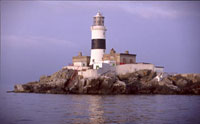
A West Cork based photographer has achieved his ambition of capturing all of Ireland's lighthouses on film. Shots taken by John Eagle of the Maidens lighthouse off the Antrim coast last week marked the conclusion of a project lasting over a decade. Weather and budgetary factors determined the length of time to capture all the lights and beacons around the 2,700 mile coastline, mostly from the air. ----------- The following was in the Irish Times Saturday Magazine Feb 2004
Blackhead, Co. Antrim (this picture and the one of the Fastnet below appeared with the article in the Irish Times magazine)
Last of the Lights writes Lorna Siggins Irish Times Marine Correspondent. Irish Times colour magazine Sat 7th Feb 2004 John Eagle would not call it an obsession it is more of a love affair. Fishguard Pier in Wales captured his heart, and the first time he saw Roche's Point marking Cork harbour, he knew that he was smitten. "The magic of the sweeping light," is how he describes it. "Coming from an inland town, there was so much excitement in the sea," he says, and lighthouses encapsulated all that... ---------------- Eagle's eye view of John Eagle used to photograph world series motorcars, travelling at an average speed of 200 miles an hour. When he switched, he did so in style - focusing his lens on immobile pieces of architecture along Ireland's 2,700mile coastline.
An Eagle Eye (July, 1998) ++++++++++++++++++++++++++++++++++++++++++++++ Irish Lighthouse Postcards by Ellamena Gregori
|
||||||||||||||||
CONTACTJohn Eagle Photography,Eyeries, Beara, Co. Cork. Irelandtel: 027 74275cell: 087 9693745Email: john@johneaglephoto.com |
|||||||||
